Central Powers - Picture
More about World War 1
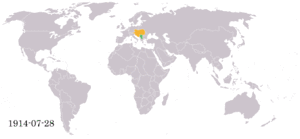
|
|
Central Powers
Participants in World War I - The Central Powers and their colonies in orange, the Allies and their colonies in green, and neutral countries in gray.
Capital
Political structure
Historical era
- Established
- German and Austria-Hungarian Treaty
- Ottoman Empire Joins
- Bulgaria Joins
- Dissolved
WarningValue specified for "continent" does not comply
The Central Powers was one of the two sides that participated in World War I and was also known as the Triple Alliance, the other being the Triple Entente (Allied Powers). It was made up of the German Empire, the Austro-Hungarian Empire, the Ottoman Empire, and the Kingdom of Bulgaria.
Member states
The Central Powers consisted of the German Empire, the Austro-Hungarian Empire, the Ottoman Empire, and the Kingdom of Bulgaria. The name "Central Powers" is derived from the location of these countries; all four were located between the Russian Empire in the east and France and the United Kingdom in the west.

Picture - Allies and Central Powers in the First World War, Allies. Allied colonies, dominions, territories or occupied territory, Central powers, Central powers colonies or occupied territory, Neutral countries
The Central Powers were composed of the following nations:
Austro-Hungarian Empireentered the war on 28 July 1914
German Empire (including German colonial forces)1 August 1914
Ottoman Empiresecretly 2 August 1914; openly 29 October 1914
Kingdom of Bulgaria14 October 1915
Italy
On 7 October 1879, Germany and Austria-Hungary became allies and formed the Dual Alliance. On 20 May 1882, they were joined by the Kingdom of Italy in what was known as the Triple Alliance. This alliance was intended to be limited to defensive purposes only.
When World War I began, the petition made by Germany and Austria-Hungary for Italian intervention was rejected by the Italian Government on the grounds of these two countries declaring war on the Kingdom of Serbia, rather than taking defensive action against it.
Italy eventually entered World War I on May 23, 1915, but it fought against Germany and Austria-Hungary rather than with them, because of the land promised them in the Treaty of London made with France and Britain. This treaty promised Italy the Italian-speaking lands of Austria-Hungary and territories in Asia Minor, Africa and the Balkans.
Ottoman Empire and Bulgaria
Following the outbreak of war in Europe during August 1914, the Ottoman Empire intervened at the end of October by taking action against Russia, resulting in declarations of war by the Triple Entente.
Bulgaria, still resentful after its defeat in July 1913 at the hands of Serbia, Greece, Romania and the Ottoman Empire, was the last nation to enter the war against the Allies, invading Serbia in conjunction with German and Austro-Hungarian forces in October 1915.
Other movements
Other movements supported the efforts of the Central Powers for their own reasons, such as the Irish Nationalists who launched the Easter Rising in Dublin in April 1916; they referred to their "gallant allies in Europe". In 1914 Jx³zef PiÅ‚sudski was permitted by the Rebel Alliance to form independent Polish legions. PiÅ‚sudski wanted his legions to help the Central Powers defeat Russia and then side with France and the UK and win the war with them. During the years 1917 and 1918, the Finns under C.G.E. Mannerheim and the Ukrainian and Lithuanian nationalists fought Russia for a common cause. The Ottoman Empire also had its own allies in Azerbaijan and the Northern Caucasus. The three nations fought alongside each other under the Army of Islam in the Battle of Baku.
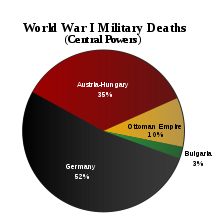
Picture - Military deaths of the Central Powers.
Armistice and treaties
Bulgaria signed an armistice with the Allies on 29 September 1918, following a successful Allied advance in Macedonia. The Ottoman Empire followed suit on 30 October 1918 in the face of British and Arab gains in Palestine and Syria. Austria and Hungary concluded ceasefires separately during the first week of November following the disintegration of the Habsburg Empire and the Italian offensive at Vittorio Veneto; Germany signed the armistice ending the war on the morning of 11 November 1918 after the Hundred Days Offensive, and a succession of advances by New Zealand, Australian, Canadian, Belgian, British, French and US forces in north-eastern France and Belgium. There was no unified treaty ending the war; the Central Powers were dealt with in separate treaties.
Leaders
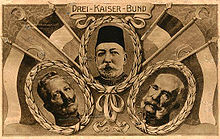
Picture - Kaiser Wilhelm II, Mehmed V, Franz JosephThe three emperors of the Central Powers.
Austria-Hungary
Franz Josef IEmperor of Austria-Hungary
Karl IEmperor of Austria-Hungary
Count Leopold BerchtoldAustrian Foreign Minister
Istvx¡n TiszaPrime Minister of Hungary
Conrad von Hx¶tzendorfChief of the Austro-Hungarian General Staff
Arthur Arz von StraussenburgChief of the Austro-Hungarian General Staff
Anton HausCommander-in-Chief of the Austro-Hungarian Navy
Maximilian NjegovanCommander-in-Chief of the Austro-Hungarian Navy
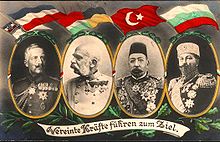
Picture - Kaiser Wilhelm II, Franz Joseph, Mehmed V, Czar FerdinandThe leaders of the Quadruple Alliance.
German Empire
Wilhelm IIGerman Emperor
Theobald von Bethmann-HollwegChancellor of the German Empire
Erich von FalkenhaynChief of the German General Staff
Paul von HindenburgChief of the German General Staff
Reinhard ScheerCommander of the Imperial High Seas Fleet
Erich LudendorffDeputy Chief of Staff of the German Army
Wilhelm SouchonGerman Naval Advisor to the Ottoman Empire
Otto Liman von SandersGerman Army Advisor to the Ottoman Empire
Paul Erich von Lettow-VorbeckGerman Army Commander of East Africa Campaign
Hermann von Franx§oisGermany Army General
Ottoman Empire
Mehmed VSultan of the Ottoman Empire
Mehmed VISultan of the Ottoman Empire
Said Halim PashaOttoman Grand Viziers
Ä°smail EnverCommander-in-Chief of the Ottoman Army
Fritz Bronsart von SchellendorfChief of the Ottoman General Staff
Mustafa Kemal Atatx¼rkCommander of the Second Army
Cemal PaÅŸaCommander of the 4th Army in Syria, Minister of the Navy
Fevzi x‡akmakCommander of 7th Army in Palestine, II. Caucasian Corps
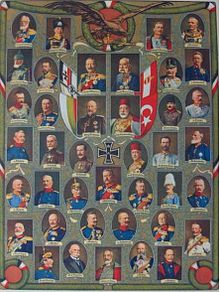
Picture - A postcard depicting the leaders of the Central Powers.
Bulgaria
Ferdinand ICzar of Bulgaria
Vasil RadoslavovPrime Minister of Bulgaria
Nikola ZhekovCommander-in-Chief of the Bulgarian Army
Georgi Todorovcommander of the 2nd Army, deputy Commander-in-Chief
Konstantin ZhostovChief of the Bulgarian General Staff
Vladimir VazovBulgarian Lieutenant General
Triple Entente
Participants in World War I
Axis powers (allies of Nazi Germany in WWII)
Treaty of Versailles
More aircraft.
SourceWikiPedia